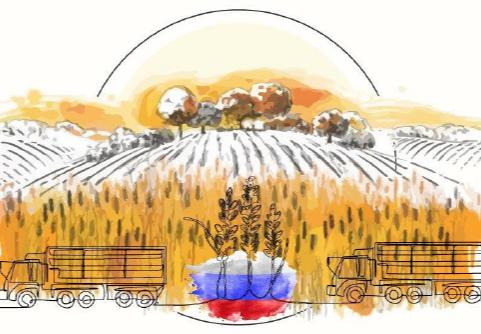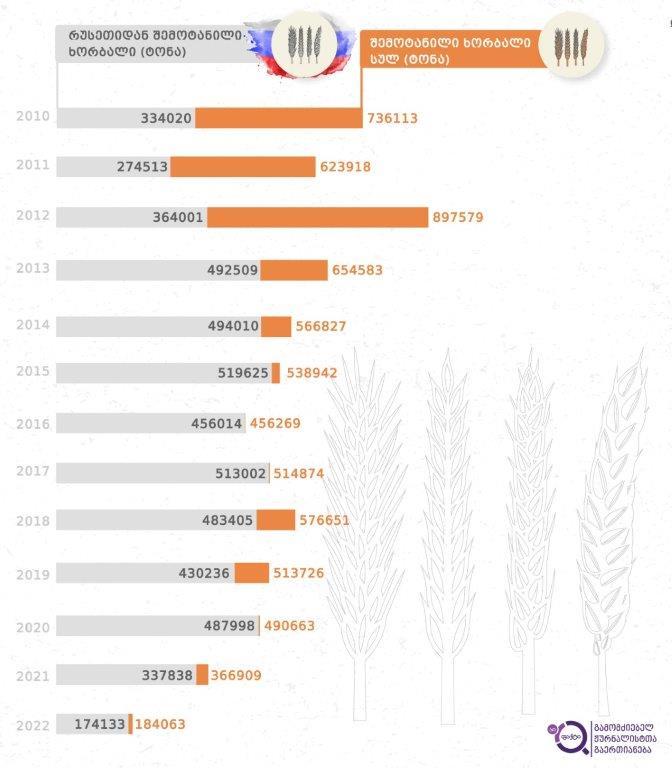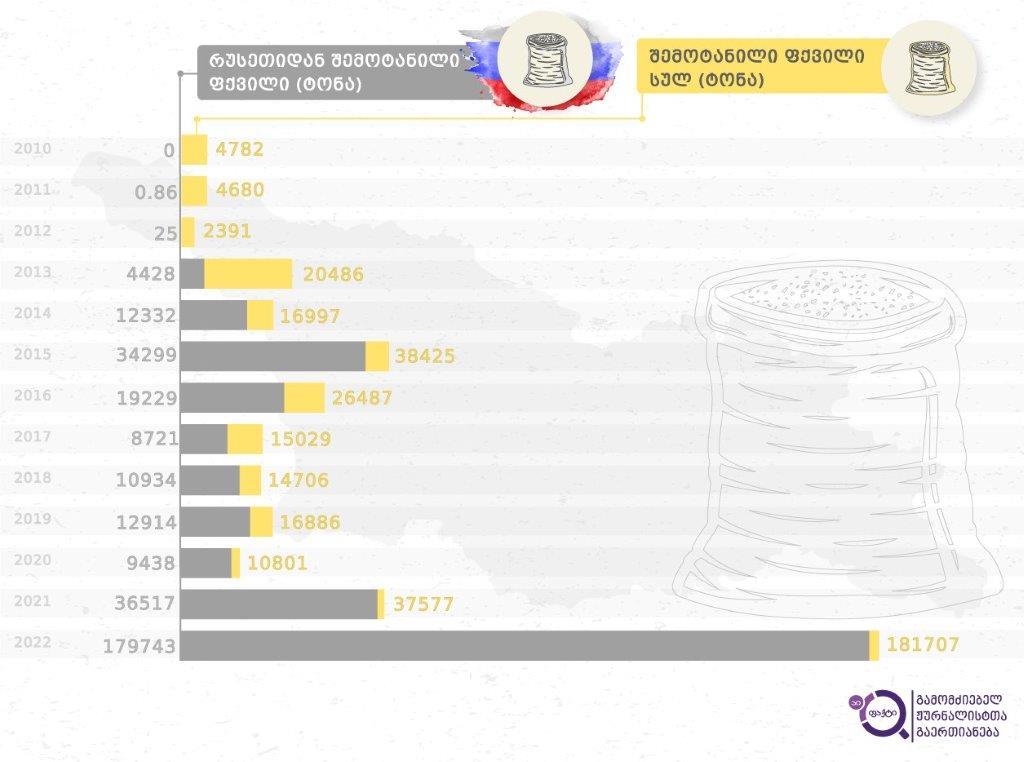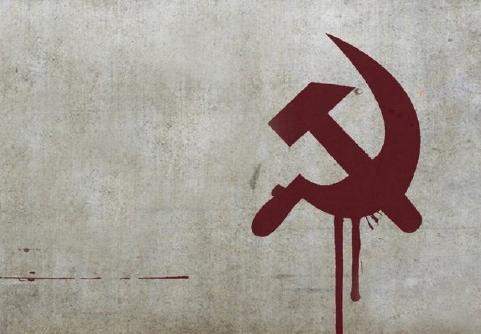
Authors : Nana Bregadze, Aidan Iusif


Russian wheat and flour pose a new threat to the economy of Georgia. Any developments in Russia directly affect our milling and baking industry. In recent years, Russia has changed its wheat export policy, which has created big problems for the Georgian industry:
● Imports of high-quality wheat have decreased, and now the country does not have even a two-month supply of this strategically important product;
● Imports of Russian flour have increased, causing serious damage to Georgian mills and Georgian wheat growers;
● The government is doing nothing to reduce dependence on Russia; moreover, Russian business interests are actively interfering in the wheat and flour milling industries.
Georgian bread has been baked from Russian wheat and flour for decades. Since 2009, we have been buying most of our wheat and flour from Russia. In terms of imports, the second and third places are usually taken by Kazakhstan and Ukraine. Official statistics show that wheat and flour imported from Russia is the cheapest. Ukrainian wheat is the most expensive, although after the beginning of the war we practically stopped imports from Ukraine.
The situation for Georgian millers and bakers remained relatively stable unt
il June 2021. However, Russia increased the tax on wheat exports, leading to a significant rise in the price of Russian wheat. Despite this increase, Russian wheat remains more affordable compared to wheat from other countries.
An additional important factor is that, unlike wheat, Russia has not imposed a tax on flour exports. Consequently, while wheat imports into the country have decreased, there has been an increase in the import of Russian flour.
 Wheat imports from Russia and total wheat imports by year
Wheat imports from Russia and total wheat imports by year
“iFact” tried to find out which companies import flour from Russia today. According to the data of the National Statistics Office of Georgia in 2021, the number of companies importing up to ten thousand tons of flour increased three times compared to the previous year, and in 2022, 187 new importers appeared on the market.
The increased price of wheat has led to the fact that the cost of flour produced in Georgia has also increased and it cannot compete with Russian flour. One bag of flour imported from Russia is 10-12 GEL cheaper than flour produced in Georgia. Therefore, the flour mills have either stopped or are milling just a little flour and working at a loss. Due to this, they had to lay off staff and they no longer buy Georgian wheat, which was used for mixing with Russian wheat.
What is the situation in the flour mills?
The rise in the price of Russian wheat posed a threat to the viability of the Georgian millers’ businesses. Industry representatives express that such a dire situation has never been experienced before. Millers are grappling with the following challenges:
● Russian wheat has become more expensive, leading to increased production costs that cannot compete with the affordability of imported flour from Russia.
● Millers have had to decrease production and lay off employees, whose knowledge and experience were crucial resources for the companies.
● Despite appeals for assistance from the government, it seems unable or unwilling to help address the issue.
Marina Katsitadze, the owner of Georgia’s oldest flour mill complex, “Progress,” situated in Rustavi, had to lay off 50 people during the crisis. To retain the remaining 150 employees, she continues to operate at a loss. However, she no longer envisions a future for her business.
“We have lost contact with major suppliers. We used to bring the wheat by ship or wagon; now we bring it by car... Now the situation is unstable, and we are following inertia. Business doesn’t resemble business anymore. The feeling that tomorrow you will be planning, preparing, thinking about changing equipment, renovation, repair – you lose the desire for it because you don’t see any reason for it,” Katsitadze shares.
Marina Katsitadze highlights that previously, they used to supply 5-7 thousand tons of wheat, equivalent to a two-month stock. Now, at most, they have supplies for 10 days, totaling up to a thousand tons. The cost of importing one ton of wheat is approximately $350. Raw materials are brought from Larsi by cars. Currently, they are processing 30 percent of production, having decreased from 4,000 tons to 1,800 tons per month.
“Considering that for the security of any country, there should be a 3-month supply of wheat, and even more so if there is a war in neighboring countries, today we are not safe. Flour is stored for 2 months, wheat – 2 years. God forbid that the flour does not arrive, you yourself understand the danger we are facing,” warns Marina Katsitadze.
 Wheat imports from Russia and total wheat imports by year
Wheat imports from Russia and total wheat imports by year
Levan Janashia has two flour mills, in Tbilisi and Gori. He says that due to the wheat export tax imposed by Russia, they are working with a 15-20 percent load compared to usual.
“This is a floating fee, the data changes every 2-3 weeks. It was set in the summer of 2021 and rose from $20 to $142, somewhere in 8-9 months,” Janashia tells us.
Since raw materials have become more expensive for the flour millers, the price of flour milled from these raw materials and produced on-site has also increased. Flour imported from Russia is not subject to any tax in Georgia; therefore, it is cheaper than locally produced flour.
“In our country, the monthly consumption of first-quality flour averages about 25-30 thousand tons. Previously, flour imported from Russia accounted for, on average, one thousand tons of this quantity. As of today, it has risen to 20 thousand tons, sometimes even more. The cost of a bag of flour was 70-72 GEL, and the selling price of imported Russian flour was 50-55 GEL. No one pays much attention to the quality there anymore because there is a big difference in price,” explains Janashia.
Lado Bidzinashvili heads the “Baraka” flour mill. His flour mill was able to process and sell approximately 2,000 tons per month before the Russian export tax was introduced. Now it has come down to 500-700 tons.
The decrease in productivity was followed by the dismissal of employees from the company: now only 40-50 people are employed out of 150.
“We are telling the state that all flour production is stopped. If we stop today, and if we want to start this production tomorrow, we won’t be able to start it again. We need a period of about 2-3 months because it is specific work. Specialized staff is needed. When the production stops, these personnel start to leave; they find work elsewhere, and it is not easy to find them after that,” explains Bidzinashvili.
Levan Janashia and Marina Katsitadze say the same thing, pointing out that there is a shortage of skilled workers in this field in our country. According to them, they managed to retain the people who are still employed, but only at the expense of losses.
The Chairman of the Association of Wheat and Flour Producers, Levan Silagava, explains that the flour mills tried to keep 60-70 percent of the workers and now about 3,000 people work in the mills of Georgia.
“Flour does not need technical staff, flour needs to be brought, sold... it needs a warehouse and accounting. The entire technological cycle does not require people. “These 3,000 people have been retained, but they will probably be released in the near future if no decision is made,” Silagava tells us. They are waiting for a decision from the government. Negotiations have been going on without results for the second year. The millers see a solution in imposing a surcharge on cheap flour imported from Russia, which the government does not agree to because it fears it will increase the price of bread. The millers here also had an opinion on how it would be possible to avoid the increase in the price of bread. It was said that the so-called social bread bakers would be supplied with flour at a cheap and fixed price.
“Social bread” is called what most of the population buys in stores every day.
“We would supply flour to bakers at their target price so that it wouldn’t get more expensive, and the price for the rest of the quantity used in confectionery or bakeries we would regulate ourselves,” Levan Janashia tells us. On 3 April, the Minister of Agriculture, Levan Shamugia, officially announced another rejection of this proposal. In response, the millers voiced a new proposal. This time, they proposed to ask the government not to tax only those 7 thousand tonnes of flour, which we import from Russia and from which bakeries bake the so-called ‘social bread’.
The chairman of the Association of Wheat and Flour Producers, Levan Silagava, says that, on average, the tax on one ton of imported flour should balance the additional tax that wheat importers now have.
“Our task is to introduce an equalizing tax, which will return the same regime for flour and wheat. 200 GEL is the average amount that would create the balance. It can be a three-month process and then it can be revised,” says Silagava.
Bread bakers do not like the solution found by the millers. The head of “Bread Bakers Association”, Malkhaz Dolidze, thinks that it would be more logical for the millers to demand a reduction in VAT and tariffs, rather than taxing imported flour, which will make flour more expensive for bakers.
It seems that flour importers are not satisfied with the current situation either.
“Mardi” LLC has been importing flour from Russia since 2014. In 2018-2021, it was among the top ten largest importing companies. We spoke to its director Nugzar Goniashvili.
“We are on our last breath... prices are falling catastrophically, and we can’t keep up with imports. Before you bring it in, you calculate the cost price, that is, what it costs you, and before you actually bring the flour to the warehouse and intend to sell it, you get a lower price on the spot,” Goniashvili tells us.
According to him, they lose on the sale of each newly introduced batch.
The main reason for this is that supply exceeds demand and new importers have appeared on the market. This is confirmed by official data. We have checked the companies that import flour from Russia to Georgia in the Public Registry database. In total, there will be 320 such entities in 2018-2023. More than 90 of these companies were established after Russia introduced a tax on wheat exports in 2021. In 2022, 187 new importers entered the market. As data from the Public Registry shows, Georgian citizens predominate among flour importers. 21 of them have dual Russian-Georgian citizenship. 11 importers are citizens of Russia. Apparently, each link of the industry faces such fundamental problems that threaten their business.
Marina Katsitadze, the owner of the “Progress” flour mill, believes that the government is willing to help them, but the results are not yet visible. Now she is waiting for the next meeting.
“Our problem concerns Georgian wheat farmers and the families of those citizens who have been laid off by the closed flour mills. They care about all this, but for some reason they are unable to address the problem. Everything ends at the level of understanding and meetings,” says Katsitadze.
What danger does Russian wheat and flour pose to Georgian wheat farmers?
Georgian wheat farmers have become another victim of flour imported from Russia. They can no longer sell wheat, and hundreds of tonnes of grain are rotting in warehouses. Millers complain about the quality of their wheat. The small amount that the mills are now grinding is mostly grain imported from Russia. Georgian wheat gets rotten and is thrown away.
According to flour millers, Georgian wheat alone is not suitable for obtaining top-quality flour. It is suitable only for mixing.
On 2 April, eight wheat producers published a video in social networks asking the state to help sell wheat. In the video they say that in previous years they already had no grain for this period, and now they cannot sell it at all. The video notes that with the help and encouragement of the state, wheat was sown and warehouses were built. Now the crops there are rotting and there is not enough space for the new crop.
We talked to Nikoloz Beniaidze, Chairman of the “Georgian Grain Producers Association”. He sowed wheat on 1,500 hectares in and around Shirak. He has been involved in this business since he was 16 years old, now he is 45 years old and says that this is the first time they have had such a crisis situation.
Previously, wheat produced in Georgia accounted for only 10-15 per cent of the entire market, and the rest was imported grain. Georgian farmers have never had problems selling wheat. This year, after the autumn, they can no longer sell grain.
There are now more than 30,000 tonnes of wheat for sale. Harvest time is approaching and they will be faced with the problem of accommodation. Along with all the benefits, if they cannot repay the bank loan, they will also face the loss of land.
“It was a cheap agro-loan, up to 100,000 GEL per farmer, which encouraged us to sow more area of wheat, which put us in a particularly bad situation, to pay 100,000 GEL, last year we needed 100 tons of wheat and this year we needed to harvest 180 tons of wheat. I took another loan now to cover the old one,” says Beniaidze. Together with Nikoloz, 46 farmers from three villages are united in the cooperative. They have sown crops on a total of 4,000 ha under cheap loan terms, and he said all of them are in this situation these days.
In 2020, another sub-component for the financing of one-year crops was added to the “Preferential Agrocredit” program, which has been in place since 2013.
Within the framework of the program, banks provide loans of up to 100,000 GEL for working capital, and the state helps farmers to pay the loan. 7,060 beneficiaries benefited from this sub-component in 2020 and 2022, of which 4,000 are wheat farmers. According to the information provided by the Ministry of Environment and Agriculture, the co-financing of loans issued by banks cost the budget more than 11 million GEL.
The ongoing changes in Russia’s wheat industry have highlighted the inconsistency of the Georgian government’s approach to the agricultural sector. It appears that the money spent from the budget over the years has neither developed the sector nor reduced the country’s dependence on Russia.
We have written twice to the Ministry of Agriculture and Environment and asked for the information on the Ministry’s policy on increasing wheat yields and improving wheat quality.
Unfortunately, we never received a concrete answer to this question.
The written response lists the programs that generally operate to finance grain crops. We asked the representative of the press office of the Ministry for help in recording an extensive interview with the responsible person; however, despite the promise, he did not assist us. Accordingly, from the given article, the reader should understand logically what policy the government is pursuing in this direction. Cheap credit and government funding have led to an increase in stocks of low-quality wheat, which, when it comes down to it, does not allow millers to operate freely.
 Wheat produced in Georgia and exported
Wheat produced in Georgia and exported
Nikoloz Beniaidze says that our wheat is mostly of medium quality. There are no funds to work on improving the quality: “This requires excellent technologies... intervention, proper nutrition, proper cultivars, suitability to the climate, and when a person cannot pay a loan, what kind of technologies are we talking about?”
In response to wheat farmers, Agriculture Minister Otar Shamugia says, there is a policy in place to increase the wheat harvest by 50 per cent. To achieve this goal, they are waiting for the conclusion of American experts: “They will study the entire value chain of wheat production and accordingly give us recommendations in the direction of promoting the industry; After that, we will already carry out additional activities”.
In July 2022, the government restricted wheat farmers from exporting grain for one year. “Taking into account the situation created in the region, in order to ensure food security, it is important to sell locally produced wheat and barley only in the domestic market,” said the then Minister of Agriculture Otar Shamugia. On April 6, four days after the wheat farmers released the video, the restriction was lifted. Farmers do not consider this a solution because the export price is unacceptable for them.
“The cost of wheat at this time last year was GEL 1.10. We planted it at that price and now we have to sell it at 55 tetri. We can’t pay off the debt, otherwise we would have sold at that price.
The export restriction has also been lifted, but it is worth 55 tetri even there and it is not profitable for us. If we sell at least at cost price, we will free the warehouses and cover part of the debt,” Nikoloz Beniaidze, chairman of the Grain Producers Association, stated in an interview with bm.ge.
Statistics show that only a small portion of wheat from Georgia is exported, and this is unlikely to significantly change the situation.
Update: The Ministry had to revise its position in light of the protests from wheat farmers and the dissatisfaction expressed by millers. On May 29, they announced that they would impose an additional fee of 200 GEL per ton on imported flour for 5 months. The regulation entered into force on June 12.










